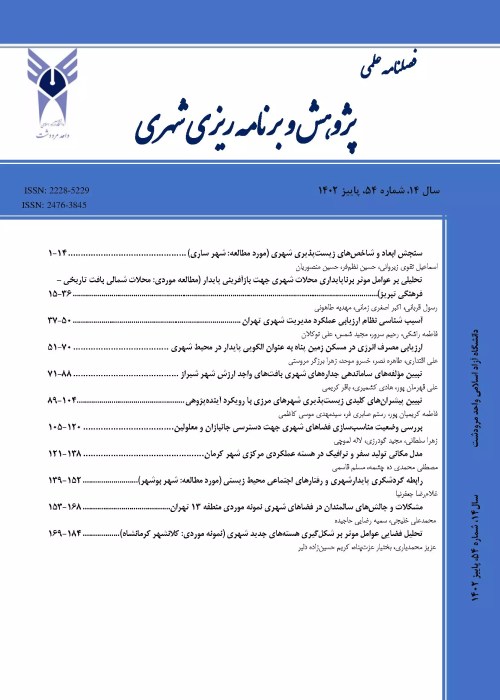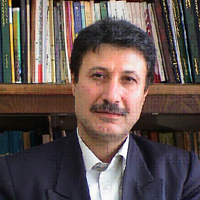Explaining resilience Strategies for urban worn out texture (Case Study: urban worn out texture of Karaj)
The main objective of this study is to achieve sustainable regeneration strategies based on resilience dimensions in Karaj city.This research is a descriptive-analytical and applied research. Data collection has been done with library-documentary studies, surveys and interviews with city administrators and authorities, as well as for data analysis using the SWOTET technique,Vickor fuzzy and Topsis fuzzy were used. The results of the study indicate that the presence of suitable agricultural lands within the physical area of the city and its surroundings, the appropriate position on the Tehran-Qazvin highway and ongoing recreational design studies are among the opportunities available in the worn-out texture of the city of Karaj. Appropriate facilities for the implementation of councils at the whole neighborhood, lack of transparency in the implementation process of the plans prepared for the citizens and the low level of hygiene and lack of services are three major threats to the worn-out texture of Karaj.Based on the resilience dimension of Karaj City's worn-out tissue regeneration perspective, it has been formulated that the Karaj City's worn-out texture should be a coherent and secure structure with a sustainable and resilient urban infrastructure, facilities and equipment that has sustainable local communities. And be resilient to dynamic economic functions and operations to cope with any crisis.Studies based on strategies can also modify the structure of access to neighborhoods based on hierarchies to provide services in times of crisis and hazardousness, safety of urban facilities and equipment, retrofit of urban facilities and equipment, and detailed feasibility of resident participation. In line with the implementation of recreation and crisis management programs, identifying the responsibilities of urban managers based on comprehensive natural disaster management plans, creating an appropriate legal framework for public participation in recreation plans and programs to enhance resilience.
Cities are like living creatures that grow and spread in the area of time and place,as they suffer from physical, functional and functional wornout,and on the other hand face natural hazards and artifacts.Therefore,the explanation of the integrated strategies of urban regeneration based on the resilience dimensions in urban worn out texture can provide a basis for reducing the vulnerability of these texture to natural and artificial hazards as well as reducing the resilience of them.Therefore, it has a high vulnerability and low resiliency in dealing with crises and hazards, and recreation of these tissues based on resilience dimensions can provide a suitable urban context to deal with any natural and artificial hazards. Geographically, it is the third country in the world to be exposed to natural hazards including earthquakes, floods, droughts, drizzles and landslides, and other factors such as the trend of urban expansion and expansion, irregular migration and urban population, lack of Considering retrofitting laws and regulations in cities, lack of facilities and readiness to deal with crises It makes Iranian cities vulnerable to natural and artificial hazards.Karaj, one of the major cities of Iran and the center of Alborz province, with 785 hectares of worn-out texture and facing natural and abnormal hazards such as earthquakes, floods, storms, fires and drift is one of the most vulnerable cities in Iran. The physical, infrastructural, social, economic, and institutional problems in the worn-out texture are facing. Therefore, explaining integrated urban regeneration strategies based on the resilience dimensions in the worn-out texture of the city of Karaj can provide a context for damage. Reduce the susceptibility of these tissues to natural and artificial hazards and resilience of worn out tissues of Karaj Greatly enhance and tissues as well as residents prepare to deal with the risks.
The main objective of this study is to achieve sustainable regeneration strategies based on resilience dimensions in Karaj city.This research is a descriptive-analytical and applied research. Also, this research is based on applied nature and also descriptive-analytical according to the research method. In order to elucidate integrated urban regeneration strategies based on resilience dimensions in Karaj city, studies have been conducted on the basis of library-documentary studies, survey surveys and interviews with city managers and authorities. In addition, fuzzy TOPSIS and fuzzy wicker methods have been used to analyze the data and formulate key pathways to explain the strategies through the combination of SWOTET technique. In this process, the first internalized, externalized and propulsion forces matrix was prepared and SWOT matrix was combined. To prepare the Internal Factor Evaluation Matrix (IFE), first list the strengths and then the weaknesses and then each of the components in the SWOT model based on three indices: 1% immediate efficiency, 2% effective intensity and 3% wide range of impacts. It was reviewed by 5 elite urban planners. The five-point Likert scale (very low, low, medium, high and very high) was used to calculate the weight of each of the resilience components in the SWOTET matrix. In this way, each of the components was weighted by SWOTET questionnaire according to the above three indices. Next, the final score of each factor is calculated to determine its final score. It should be noted that if the average of any internal factors is less than 2.5, the neighborhood is weak in terms of internal factors and if the average score is greater than 2.5, it means the neighborhood is strong. In the next step, after determining the weight of each of the criteria and indices of indoor and outdoor environment, SWOTET matrix is presented. In this way, the prioritized matrices of the inner and outer environment as well as the driving forces will be identified and displayed in the matrix. These matrices form the basis of the formulation of the guides or suggested research strategies. The driving forces include 1- positive trend (PT), 2- negative trend (NT), 3-positive event (PE) and 4-negative negative event (NE). Identified in the worn-out area of the city of Karaj and can have undeniable effects on the resilient regeneration process.
According to SWOTED analysis, TOSIS FUZY and VIKOR FUZZY techniques of Route 3 which aim to enhance the resilience of worn-out tissue in Karaj due to the intensification of informal tissue burnout and the widespread distribution of worn-out tissue in Karaj. In addition, based on the resilience dimension, the perspective of regeneration of the worn-out tissue of Karaj city can be formulated as follows: Karaj city worn-out texture with a secure and coherent structure with stable, resilient urban infrastructure, facilities and equipment that has sustainable local communities. Resilient to dynamic economic functions and operations to deal with any crisis and risk that has organizations and plans in the field of regeneration of the worn-out texture of Karaj with regard to sustainable regeneration approaches and indicators, resilience and crisis management. All in all, the results of the study indicate that the presence of suitable agricultural lands within the physical area of the city and its surroundings, the appropriate position on the Tehran-Qazvin highway and ongoing recreational design studies are among the opportunities available in the worn-out texture of the city of Karaj. Appropriate facilities for the implementation of councils at the whole neighborhood, lack of transparency in the implementation process of the plans prepared for the citizens and the low level of hygiene and lack of services are three major threats to the worn-out texture of Karaj. Based on the resilience dimension of Karaj City's worn-out tissue regeneration perspective, it has been formulated that the Karaj City's worn-out texture should be a coherent and secure structure with a sustainable and resilient urban infrastructure, facilities and equipment that has sustainable local communities. And be resilient to dynamic economic functions and operations to cope with any crisis. Studies based on strategies can also modify the structure of access to neighborhoods based on hierarchies to provide services in times of crisis and hazardousness, safety of urban facilities and equipment, retrofit of urban facilities and equipment, and detailed feasibility of resident participation. In line with the implementation of recreation and crisis management programs, identifying the responsibilities of urban managers based on comprehensive natural disaster management plans, creating an appropriate legal framework for public participation in recreation plans and programs to enhance resilience.
- حق عضویت دریافتی صرف حمایت از نشریات عضو و نگهداری، تکمیل و توسعه مگیران میشود.
- پرداخت حق اشتراک و دانلود مقالات اجازه بازنشر آن در سایر رسانههای چاپی و دیجیتال را به کاربر نمیدهد.



